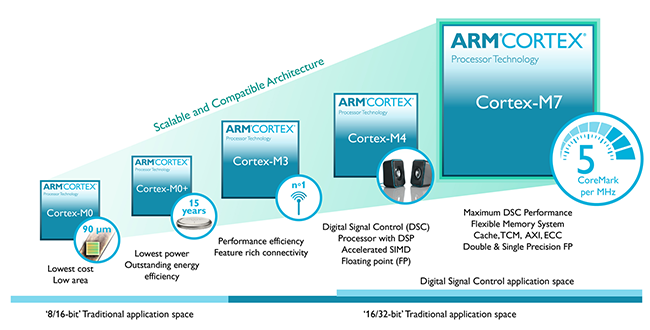ARM Cortex-M
The Internet of Things (IoT) is a term used to describe the growing number of connected devices that communicate with each other without the need for human intervention. In its simplest form IoT is about making devices smart enough to be aware of their context and to function accordingly. IoT therefore requires devices to be infused with some form of sensing technology and intelligence, for this sensing to be networked to other devices, and the data from the sensors to be accurately interpreted, often by analysis conducted elsewhere.
Real-world examples of IoT range from macro-sized opportunities such as making cities smarter through the use of intelligent energy consumption, more efficient traffic management, and a more responsive and reactive health care system, through to person-specific IoT in the form of fitness tracking and health monitoring. At the core of IoT is sensors and networking, and this is where ARM comes in.
ARM's expertise in designing low-power processors is integral to the widespread adoption of IoT and, on the device side, to wearable technology. Want a street light to be smart enough to adapt to ambient conditions? It's likely powered by ARM technology. Want to know your pulse rate when running? The chip inside your smartphone or heart-rate monitor is likely to be based on ARM technology. What's more, the communication between the monitoring chip and data-analytics device, usually a smartphone or watch, is driven by ARM technology, too.
Given the ultra-wide breadth of possible IoT usages the opportunity is enormous. It is estimated that over 20 billion devices will be connected in the IoT sense by 2020, according to Gartner, so what is ARM doing to facilitate this growth? IoT is where the ARM Cortex-M series of processor play a key role.
These small-scale processors are built with energy-efficiency very much in mind. Found in power-sensitive platforms and typically driving general-purpose microcontrollers, sensors and USB/Ethernet controllers - the backbone of IoT, if you will - they're practically everywhere. Underscoring this point, scanners, alarm systems, power supplies, white goods and medical devices, to name but a few, all use ARM Cortex-M series technology, which is counted in billions of units per year.
Maintaining compatibility with the widely-used 32-bit ARM instruction set, each product in the Cortex-M series is positioned to meet a specific requirement, usually in regards to energy efficiency and performance, yet each part can be further customised by ARM's partners to suit the needs of the target application. The configurability of the Cortex-M is a key of reason why it's such a good fit for the various strata of IoT.
ARM says there are many thousands of combinations for Cortex-Ms available from a range of partners, and the wonderfully broad scope of use means ARM subdivides Cortex-M into five products.
The Cortex-M0+ is the lowest-power processor in the ARM arsenal. Retaining architecture consistency with the rest of the Cortex-M lineup, this tiny processor, composed of just 12,000 gates, is purposely designed to excel in sucking on minuscule amounts of power.
Cortex-M0, meanwhile, is the smallest processor with a slightly more involved architecture, thus adding to the computational potential but also increasing power consumption a touch. But the simpler overall design means it is the cheapest Cortex processor available, and is useful for general data processing and I/O control tasks.
Cortex-M3 and Cortex-M4 are more feature-rich and faster processors with the Cortex-M4 primed for digital signal control processors (DSPs) and floating-point-intensive work. Both are based on the ARM v7-M architecture and can be frequency-scaled up to 200MHz, depending upon how fast a partner wants to make it.
At the top of the stack and deliberately designed to power the most intensive of energy-efficient devices, the recently introduced Cortex-M7 offers Cortex-A-class-like performance but, crucially, with that all-important energy efficiency in mind. The Cortex-M7 has twice the DSP performance of the Cortex-M4. ARM sees the Cortex-M7 as the go-to solution for designers of the latest wave of wearables requiring higher DSP performance.
ARM is not standing still however, having launched ARMv8-M, the next version of the architecture for Cortex-M processors. ARMv8-M brings ARM TrustZone security technology to Cortex-M making it easier and more efficient to implement security in even the smallest of IoT nodes.
What makes the Cortex-M processor series seem incredible is just how efficient and small the processors can be. As an example, ARM's lowest-power CPU - the Cortex-M0+ - consumes just four microwatts for every MHz - and, remember, a microwatt is one-millionth of a watt. Perhaps even more illuminating is the tiny size of the CPU, measuring a tiny 0.009mm².
Best-in-class power efficiency, incredible choice made possible by near-endless customisation, and years of reliable service means that the ARM Cortex-M series family is the go-to solution for companies requiring advanced microcontrollers. It will therefore not surprise you to learn that ARM Cortex-M technology is also found at the heart of most wearable devices shipping today. Think IoT, think ARM Cortex-M.








